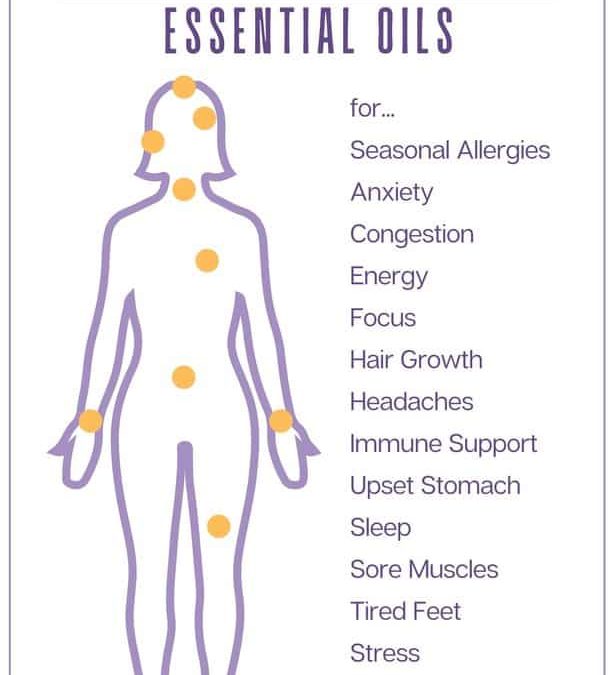When I first started using essential oils, I used a diffuser. I liked how good the essential oils made my house smell, and I loved the aromatherapeutic benefits I was experiencing, like lavender helping me sleep better at night, or peppermint helping soothe a headache. However, sometimes it is more beneficial to apply essential oils directly on the body, like when trying to ease an upset stomach or when treating thinning hair.
I needed to learn when to put essential oils on the body, where to apply them, and how to dilute oils properly so they are effective without causing harm.
In this post, I compiled a lot of things I’ve learned about applying essential oils topically, and in sharing some of my journey and I hope it assists you in yours.
Where Is the Best Place on the Body to Apply Essential Oils?
There is no single perfect place on the body to apply essential oils.
How Do You Apply Essential Oils Directly to the Skin?
When applying essential oils topically to skin, always dilute them with a carrier oil (such as, coconut oil, sweet almond oil, jojoba, or olive oil). Essential oils are very powerful, so it’s better to be safe than sorry.
In addition to diluting essential oils, I also do a skin patch test the first time I use an essential oil topically.
To do an essential oil patch test:
Where to Apply Essential Oils for Seasonal Allergies
When seasonal allergies flare up, apply essential oils to the pulse points behind your ears as well as your inner wrists. Then rub wrists together, raise wrists to just below your nose, and inhale deeply. By using both topical application and aromatherapy (breathing oils in), the essential oils will enter your bloodstream more quickly and your seasonal sneezing and itchy, watery eyes should lessen.
a few essential oils that help with seasonal allergies: lavender, lemon, peppermint
Are you ready to make this?
Where to Apply Essential Oils for Anxiety
If you’re feeling anxious or nervous, you can massage essential oil onto your inner wrists, behind your ears, over your heart and chest, and back of neck. These key pulse points will quickly take the essential oils where they need to go to help relieve anxiety and calm both your mind and body.
For additional calming support, put essential oil and carrier oil in palm of your hand, then rub palms together, cup hands over nose and mouth, and breathe in deeply. Breathe in for count of four, hold for four, and then exhale for count of four. Repeat as needed.
a few essential oils that help with anxiety: bergamot, lavender, sweet orange
Are you ready to make this?
Where to Apply Essential Oils for Congestion
For stuffy, runny nose and congestion, massage diluted essential oils into upper chest, neck/throat, behind ears, and down back of spine. The topical application of essential oils, combined with the proximity of oils to nose and mouth, helps you breathe in the oils while they are also being absorbed in through your skin. This will help loosen mucus in your chest and nose, helping you to breathe clearer in no time.
a few essential oils that help with congestion: eucalyptus, peppermint, tea tree
Are you ready to make this?
Where to Apply Essential Oils for Energy
We all need a little extra energy from time to time. Whether that’s to help wake up in the morning, get through an afternoon energy slump, to refresh and revitalize yourself to get through a big project. When you’re feeling tired or lacking motivation, apply essential oils to crown of head, back of neck, behind ears, over heart/chest, or inner wrists for energy boost to help wake you up and make the most of your day. After applying to inner wrists, rub wrists together and deeply inhale aroma, making an effort to breathe deeply and intentionally for several seconds.
a few essential oils that help with energy: peppermint, sweet orange, grapefruit, fir
Are you ready to make this?
Where to Apply Essential Oils for Focus & Concentration
When your mind wanders and you need you need to get back on task, apply essential oils to your temples, crown of head, and inner wrists. After applying to wrists, we rub wrists together and deeply inhale aroma, making an effort to breathe deeply and intentionally for several seconds. This will help reduce brain fog and improve concentration.
a few essential oils that help with focus: lemon, rosemary, fir, peppermint, sweet orange
Where to Apply Essential Oils for Hair Growth
As we get older, women commonly struggle with thinning hair and hair that just doesn’t grow as quickly. To help hair grow in faster, thicker, and stronger, apply diluted essential oils to crown of head. Then massage in for at least 15-30 seconds to stimulate blood circulation in scalp and increase essential oil effectiveness. For best results with hair growth, use essential oils on scalp daily.
a few essential oils that help with hair growth: lavender, rosemary, cedarwood, peppermint
Are you ready to make this?
Where to Apply Essential Oils for Headaches
When a headache comes on, apply diluted essential oils to your temples, crown of head, behind ears, and back of neck. This can be done any time of day. It can be especially relaxing at night when you need to tune out your brain and get a great night’s sleep. Additionally, if you get headaches frequently, you can even apply essential oils before you get a headache to help prevent a migraine or tension headache from starting.
Note: When applying essential oils to temples, be careful to not roll on too much and be sure to keep essential oils away from the eyes. If essential oil does get in the eyes, do not use water to try to get the oil out; water will drive the oil further in. Instead dab the eye with a carrier oil (like coconut oil) or splash the eyes with whole milk to dilute the oil.
a few essential oils that help with headaches: peppermint, lavender, frankincense, Roman chamomile
Are you ready to make this?
Where to Apply Essential Oils for Immune Support
To help support a healthy immune system, apply diluted essential oils to spine, over heart, and to bottoms of feet. After applying essential oils to feet, let them soak in a bit, then cover with socks.
a few essential oils that help with immune support: lemon, frankincense, tea tree, eucalyptus, rosemary
Are you ready to make this?
Where to Apply Essential Oils for Indigestion and Upset Stomach
When your stomach is upset, apply diluted essential oils to your abdomen. Start near your navel and gently massage the essential oils in rubbing in a clockwise direction. This application method works whether it’s indigestion, bloating, nausea, or general stomach upset. For heartburn, continue gently massaging diluted essential oils from stomach up through chest and neck. For motion sickness or other nausea, it’s also helpful to put a small amount of diluted essential oils in the palms of your hands, then rub hands together, cup hands over nose and mouth, and breathe in deeply.
a few essential oils that help with indigestion and upset stomach: ginger, fennel, peppermint, coriander
Are you ready to make this?
Where to Apply Essential Oils for Sleep
If you’re having trouble getting a good night’s sleep, apply diluted essential oils to your chest, neck, big toe, and inner wrists. The essential oils will not only help you fall asleep faster, but they’ll also help you stay asleep so that you wake up in the morning fully rested and ready to take on the day.
a few essential oils that help with sleep: lavender, cedarwood, vetiver, ylang ylang, Roman chamomile
Are you ready to make this?
Where to Apply Essential Oils for Sore Muscles
For sore muscles, rub diluted essential oils directly onto the area experiencing muscle tension, soreness, stiffness, or pain. Frequent places suffering from muscle soreness are neck and shoulders, back, legs, and arms. The essential oils help improve blood circulation, relieve pain, reduce inflammation, act as a natural numbing agent, and evoke cooling and warming sensations, all to help soothe muscle tension and soreness.
a few essential oils that help with sore muscles: wintergreen, peppermint, lavender, lemongrass, black pepper
Are you ready to make this?
Where to Apply Essential Oils for Tired Feet
After a long day, applying diluted essential oils to the bottom of your feet may help reduce foot soreness and fatigue.
a few essential oils that help with sore and tired feet: peppermint, marjoram, cypress, lemongrass
Are you ready to make this?
Where to Apply Essential Oils for Stress
If you’re feeling stressed or on edge, you can massage essential oil onto your inner wrists, behind your ears, over your heart and chest, and back of neck. These key pulse points will quickly take the essential oils where they need to go to help relax both your mind and body.
For additional calming support, put essential oil and carrier oil in palm of your hand, then rub palms together, cup hands over nose and mouth, and breathe in deeply. Breathe in for count of four, hold for four, and then exhale for count of four. Repeat as needed.
a few essential oils that help with stress: lavender, cedarwood, ocotea, copaiba
Are you ready to make this?
Please note: Products mentioned in this article have not been evaluated by the FDA. These products and information on this page are not intended to diagnose, treat, cure, or prevent any disease. This website is not a substitute for professional care. Always consult your medical doctor regarding your medical care. Never disregard professional medical advice or delay in seeking it because of something you have read on this website.
Disclaimer: Please know that this website contains affiliate links. This means that should you click on certain links, and then subsequently purchase a product, I will receive a small commission. The price is exactly the same for you as it would be without the affiliate link.
This content was originally published here.

